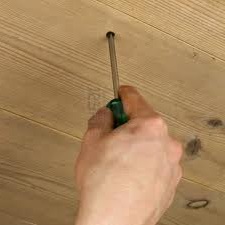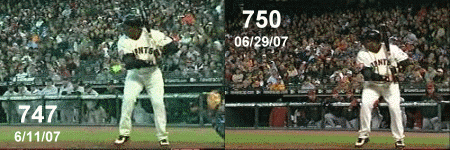
Just as the screw driver will turn the screw.....the rear leg will turn the rear hip socket.
The relationship between the rear leg and the rear hip socket is tightened when the rear hip coils. It is tightened more when the rear leg internally rotates. A hitter reaches the 'range of motion limit' within the hip socket. It is tight. The rearward coiling action of the rear hip, against the internally rotating action of the leg creates a 'tug of war' like feeling in the rear hip socket. The rear hip is coiling rearward. The rear leg is internally rotating forward. Range of motion limit is reached....yet the pressure continues to build as both continue to create force in opposite directions. THAT is part of the stretch of the SnF. The rest of it is in the rear lower back and the upper back/scap action. When the rear lower back continues to 'pull back and around', along with the coiling hip, and the scap pinches or clamps down, your entire torso becomes the SCREW. The hip socket itself is the head of the screw. The stretched/twisted torso, up through the scap, becomes the leg of the screw. The leg is the SCREW DRIVER. It is turning opposite of the hip/back/scap. The hip/back/scap are producing great resistance, just like a screw that is already screwed in, that you are attempting to remove. The resistance of a well sunk screw resembles the resistance provided by the coiling hip/back/scap. The internally rotating rear leg resembles the twisting action of the screw driver that is trying to back out that well sunk screw.
So....you have the hip/back/scap applying force rearward and the internally rotating leg applying force forward....both are a turning force....which resembles the screw's resistance against the screw driver's turn. What do you do when the screw is REALLY tight? You apply pressure INTO the screw. You apply pressure to tighten the screw driver tip's grip on the screw. In hitting you 'sit' onto the ball of the femur. The screw's head, the hip socket, 'sits', directs weight downward, onto the ball of the femur, so that it's grip is tightened. The forces continue to pull in opposite directions but now you have a downward force applied also to help the grip. As a hitter starts to move out....the entire assembly, which is in a state of 'tug of war' moves/turns forward. The grip tightens even more. The leg/hip assembly, that is still in a state of 'tug of war', TURNS FORWARD. THE ASSEMBLY TURNS FORWARD. The back and scap action, their 'pulling back and around', resists that forward turn....which takes the stretch all the way to the scap/spine junction. At this point, the leg's internal rotation is FELT at the scap. You feel the leg of the screw turn, which reaches all the way to the scap/spine junction. You have moved the tug of war to where it is no longer just between the hip socket and the ball of the femur. It is now between the leg and the scap/spine junction, because everything between has been fused into a unit. The back and scap pulling back fuses the torso into a unit. The axis becomes the line from the rear hip to the scap/spine junction. THE AXIS IS THE SCREW....which is a line from the rear hip socket to the scap/spine junction. IT IS NOT THE SPINE. IT NEVER WAS. IT WILL NEVER BE, in the high level swing. Your screw's leg reaches all the way to the scap because of the pull backs of the muscles IN YOUR BACK. When the leg turns the hip socket, the screws head, it also turns 'the leg of the screw', which reaches up into the scap/spine junction. At the point of 'go'.....the leg wins.....the leg defeats the rearward resistance....the screw turns....which means the torso turns....about the SCIP (scap/rearhip axis) and the energy exits the hands, which happen to be right at/near connected to, the scap through the forearms barrel turn....which happens with....in the same direction as....simultaneous to.....the turn of the SCIP. Therefore, the energy of the leg's turn goes directly into the hands/forearm's turn of the barrel. The LEG drives the barrel WITH the hands....simultaneously. You get two turning forces applied directly to the barrel. The forces that build up from the hip socket, through the fused torso, around the SCIP.....(around the screw's leg) act WITH, in the same direction as, the forearms barrel turn. Those TWO forces, working together, in the same direction, at the same time, accelerate the barrel INSTANTLY when the stretch from the SnF load is released.
That instantaneous release of energy, DIRECTLY into the barrel, is what is special about the high level swing. The LEG ITSELF turns the barrel. It does not provide just a push forward to gain momentum from which you push your hands. It literally TURNS THE BARREL. It DRIVES the barrel because of the screw....because of the fused torso.
The number of moving links in the kinetic chain is reduced. AND THIS IS HUGE. Too many links means too slow of a swing. Too many links means a lack of suddenness. Suddenness is critical to the high level swing. Because links are fused together, reducing the number of links....and because of the body's ability to build and store the energy through the SnF process, you reach a level of suddenness that is necessary to deal with high level pitching. You reach a suddenness needed to deal with 95+, but you also reach a level of suddenness that allows you to wait, delay the release, for the 75mph off speed pitch, or the moving 85mph pitch....and still have great batspeed.
This kind of suddenness.....

On the left, suddenness ready for the fastball. On the right, suddenness ready but delayed slightly, then released.
Both generated sufficient batspeed.
Suddenness of release is the only way to deal with good pitching. Suddenly getting your barrel up to speed is the only answer. EARLY BATSPEED.....before the hands move....is critical.
ONLY Hittingillustrated.com knows and understands how to teach these high level mechanics.

He needed it to get dark so we couldn't hit before he could show up.
It's just the facts, guys. The effort these bozos make to cover up their nonsense....to save their ego.....while selling kid after kid down the river.....is shameful.
FOUR hitters, who swing in the high level pattern, 3 of which I've worked with in person, 1 whose dad has been a member of my site since day one in 2006.
NO ONE ELSE ON THE INTERNET HAS ONE.
My most vocal critics....are so ashamed of their own work....that they don't dare post it.
Deal with it.
Push It Forward Versus SnF Release
The first demo is of Wellphyt's pushing hip. All you do is muscle up to push/rotate the hips as hard as you can.
The second....correct....demo....is of a SnF launch....once the hip is coiled against an internally rotating leg.
In both instances, my left hand represents the hip.
In the first demo it pushes.
In the second demo it RESISTS.